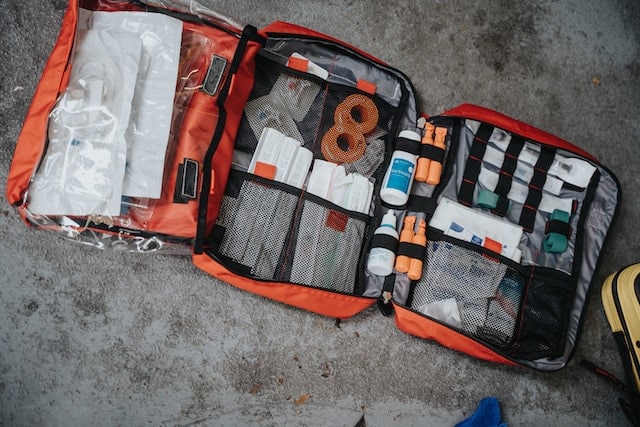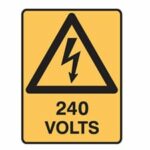Accidents and injuries can happen at any time, whether you’re at home, on the road, or enjoying outdoor activities. Having a well-equipped first aid kit is essential to provide immediate care and prevent minor incidents from turning into major problems.
In this blog post, we’ll guide you through the 12 must-have items for your first aid kit, ensuring you’re prepared for emergencies and capable of offering assistance when needed.
Why Do You Need a First Aid Kit?
A first aid kit is designed to provide the necessary supplies for treating minor injuries and illnesses. It’s important to keep a well-stocked first aid kit in your home, vehicle, workplace, and when you’re out camping or engaging in an outdoor activity.
By having all of the items readily available, it enables you to provide assistance quickly and effectively while avoiding further harm.
What You Need in Your First Aid Kit
It’s essential to have the right items in your first aid kit. Here are 12 of the most important items that should be included:
1) Adhesive Bandages of Various Sizes
Adhesive bandages are the most common items in any first aid kit. They are perfect for covering small cuts, abrasions, and blisters. It’s essential to have a variety of sizes to accommodate different wound types. Make sure your first aid kit includes an assortment of adhesive bandages, ranging from small strips to larger dressings.
2) Sterile Gauze Pads and Rolls
For larger wounds or more severe injuries, sterile gauze pads and rolls are indispensable. These absorbent dressings are ideal for covering wounds and applying pressure to control bleeding. Make sure to keep an adequate supply of gauze pads and rolls in your kit.
3) Antiseptic Wipes and Solution
Cleaning wounds promptly is crucial to prevent infections. Include antiseptic wipes and solutions in your first aid kit to disinfect wounds before applying dressings. These items will help reduce the risk of bacterial contamination and ensure proper wound care.
4) Medical Tape
Medical tape is necessary for securing gauze and dressings in place. Opt for hypoallergenic adhesive tape to minimise the risk of skin irritation. This versatile item is essential for providing effective wound care.
5) Scissors and Tweezers
Scissors and tweezers are handy tools for cutting medical tape, gauze, or clothing near a wound. Tweezers are also useful for removing splinters and foreign objects from the skin. Ensure that these instruments are made from stainless steel and have pointed tips for precision.
6) Instant Cold Packs
Instant cold packs provide immediate relief for swelling, sprains, and strains. These single-use packs do not require refrigeration and can be activated by squeezing or shaking. Adding them to your first aid kit will help alleviate pain and reduce inflammation.
7) Elastic Bandages
Elastic bandages, also known as compression bandages, are vital for providing support to injured joints and muscles. They help reduce swelling and provide stability, making them essential for sprains, strains, and other injuries.
8) Disposable Gloves
Disposable gloves are crucial for maintaining proper hygiene and preventing the spread of infections during first-aid procedures. Choose latex-free gloves to accommodate those with latex allergies.
9) Pain Relievers and Medications
Over-the-counter pain relievers like acetaminophen or ibuprofen can be included in your first aid kit to manage pain and reduce inflammation. Additionally, if you or your family members have any prescription medications, consider keeping a small supply in your kit, especially during outdoor activities or travel.
10) CPR Face Shield or Mask
In case of a medical emergency, having a CPR face shield or mask is vital. These devices create a barrier between the rescuer and the injured person during cardiopulmonary resuscitation (CPR), reducing the risk of disease transmission.
11) Emergency Contact Information
Always have a list of emergency contact numbers, including local emergency services, your doctor’s contact details, and important personal contacts. In stressful situations, having this information readily available can be invaluable.
12) First Aid Manual or Guide
Even with all the necessary items, knowing how to use them effectively is crucial. Include a first aid manual or guide in your kit, providing step-by-step instructions for various injuries and medical situations.
Customise Your First Aid Kit
Tailoring your first aid kit to meet your specific needs is essential. Consider adding items such as allergy medication, insect repellent, sunscreen, or any other medications relevant to your family’s health needs.
If you’re outdoors often or plan to go camping, make sure to include additional supplies in your first aid kit. Flashlights, emergency blankets, and snacks can be lifesavers during unexpected situations.
Having a well-stocked first aid kit is essential for treating minor injuries and illnesses. With the right items at hand, you will be prepared for any medical emergency that may
First Aid Kit for Travel
When travelling, your first aid kit should be portable and tailored to the activities you plan to engage in. Consider including items like
-motion sickness medication
-antidiarrheal medication
-traveller’s diarrhea remedy
-insect bite relief medicine
-sunburn relief lotion
-eye drops
-oral rehydration solution for dehydration
Be sure to check the local laws and regulations of the areas you’ll be visiting, and include any necessary items as well.
First Aid Kit for Outdoor Activities
If you enjoy outdoor activities like hiking or camping, your first aid kit should be equipped to handle common outdoor injuries like cuts, burns, and insect bites. Some important items to include are:
-a multi-tool with a knife, scissors, and tweezers
-splinter removers
-burn ointment
-tweezers for removing thorns or prickly plant materials
-wound closure strips to seal lacerations or cuts without stitches
-sunscreen and lip balm with SPF protection
-a survival blanket to keep you warm in cold weather
-safety pins for securing bandages or torn clothing
First Aid Kit Maintenance
Regularly inspect and restock your first aid kit to ensure that all items are in good condition and within their expiration dates. Here are some tips for maintaining your first aid kit:
- Check expiration dates on all medications and replace them as needed.
- Replace any used items like gloves, bandages, and antiseptic wipes.
- Keep the contents organized to make sure everything is easily accessible.
First Aid Training
Possessing a well-stocked first aid kit is only half the battle. It is a good idea to enrol in a first-aid training course to learn how to respond effectively to emergencies and provide life-saving care when needed.
Conclusion
A well-prepared first aid kit is a fundamental component of your safety toolkit. By including these 12 must-have items, customizing your kit, and staying knowledgeable about first aid procedures, you can be ready to handle a wide range of emergencies effectively.
Remember to regularly check and update your first aid kit to ensure that it remains a reliable resource in times of need. Whether you’re at home, on the road, or enjoying outdoor adventures, a properly equipped first aid kit can make all the difference in promoting quick recovery and well-being.
At Jabac, we offer a range of first aid kits to suit any need. Browse our store today to equip yourself with the essential tools to help you stay safe and prepared.
Important Tips for First Aid Administration
When administering first aid, it’s important to
Frequently Asked Questions (FAQs)
How often should I check and restock my first aid kit?
It’s recommended to check your first aid kit every three to six months or more frequently if you use it regularly. Restock any used or expired items promptly.
Can I use hydrogen peroxide to clean wounds?
While hydrogen peroxide was commonly used for wound cleaning in the past, it can damage healthy tissues and slow down the healing process. Stick to mild antiseptic solutions or simply clean wounds with soap and water.
Should I keep a first aid kit in my car?
Absolutely! Having a first aid kit in your car is essential for handling injuries while on the road. Include items like adhesive bandages, antiseptic wipes, and instant cold packs.
Are there any specific items I should include in a first-aid kit for young children?
For a first aid kit catering to young children, consider adding children’s pain relievers, child-sized bandages, and medications for common childhood ailments.
Categorised: 2023





